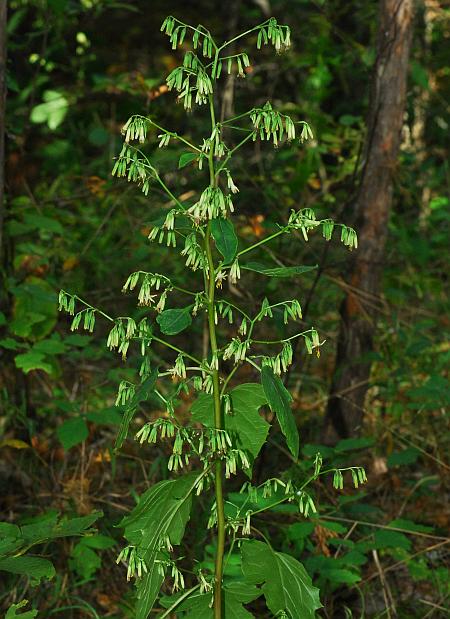Nabalus altissimus (L.) Hook.
Tall White Lettuce

Native
CC = 5
CW = 3
MOC = 32
© SRTurner
Nabalus altissimus (L.) Hook.Tall White Lettuce | |
 |
Native CC = 5 CW = 3 MOC = 32 |
© SRTurner |
|
Family - Asteraceae/Cichorieae Habit - Perennial forb, usually with somewhat tuberous-thickened rootstocks, often producing offsets and then colonial. Latex white. Stem - Erect, to 2.5 m, slender to stout, usually glabrous, often with purple coloration, sometimes glaucous.
Leaves - Basal and alternate, petiolate, highly variable. Springtime emergent leaves often deeply lobed or with indistinct hastate lobes at bases. Basal and lower stem leaves long-petiolate, the blade 4-20 cm long, broadly ovate to broadly triangular, usually with 1 or 2 pairs of triangular or ovate basal lobes, the margins often with few to several often irregular, broad, spreading teeth or shallow lobes. Median and upper leaves gradually reduced, with progressively shorter petioles, the blade entire or more commonly finely to coarsely toothed or shallowly pinnately lobed, sometimes even those of the upper leaves deeply 3-lobed, triangular to ovate or ovate-elliptic. Leaf surfaces glabrous or nearly so, the undersides pale but not glaucous.
Inflorescence - Narrow to broad panicles, the heads tending to be clustered toward the branch tips, terminal and often also from the upper leaf axils, sometimes with additional small clusters of heads below the main inflorescence, the heads commonly nodding or pendent.
Heads - Ligulate. Involucre 9-14 mm long, the inner bracts 4-6, rounded to sharply pointed at the often somewhat incurved or outcurved tip, glabrous, pale green with a darker green base, not glaucous or pebbled. Receptacle naked.
Flowers - Ligulate florets 4-6. Corollas 7-15 mm long, greenish yellow to cream-colored or pale yellow, sometimes appearing nearly white. Pappus 5-6 mm long, orangish brown.
Fruits - Achenes 4-5 mm long, light brown or yellowish brown. Flowering - July - October. Habitat - Swamps, streambanks, mesic and bottomland forests, bluffs. Origin - Native to North America. Lookalikes - None close. Other info - This interesting species is somewhat scattered in Missouri and mostly restricted to the southeastern half of the state. Elsewhere its range extends throughout most of the eastern continental U.S. and into Canada. The plant is recognized by its open inflorescences of pale, smooth, tubular flowering heads which hang downward. The leaves are highly variable, ranging from extravagantly lobed to unlobed. Typically, the basal and emergent springtime leaves are the most lobed, with the upper stem leaves the least so. The plant is most commonly found in moist areas with light to moderate shade. Photographs taken at LaBarque Creek Conservation Area, Jefferson County, MO, 9-19-2008 and 9-24-2014, Taum Sauk State Park, Iron County, MO, 9-27-2010, Glassberg Conservation Area, Jefferson County, MO, 5-13-2013 and 9-25-2015, Valley View Glade Natural Area, Jefferson County, MO, 9-28-2014, and Young Conservation Area, Jefferson County, MO, 4-12-2017 (SRTurner). |